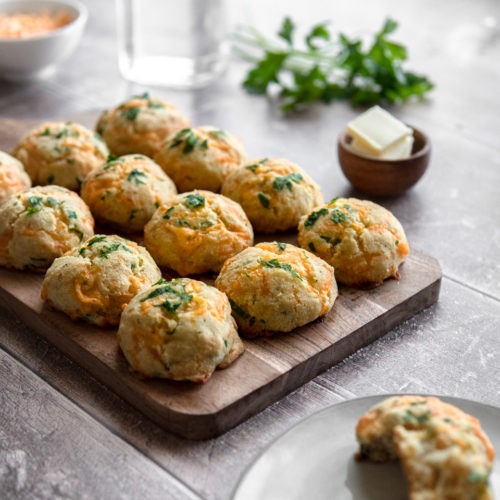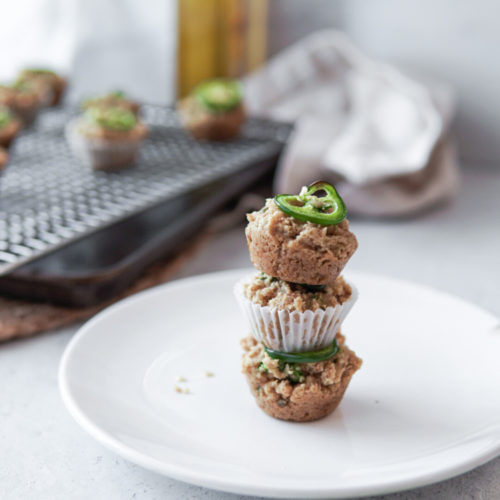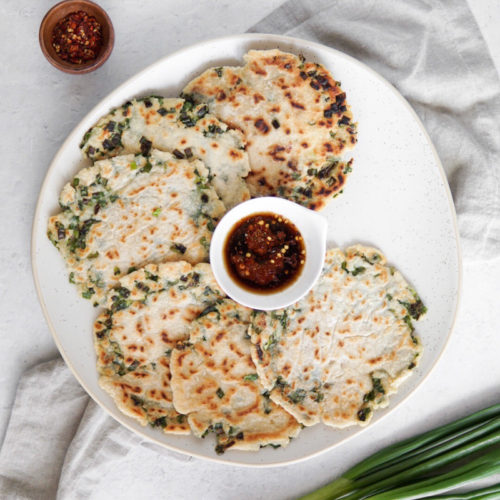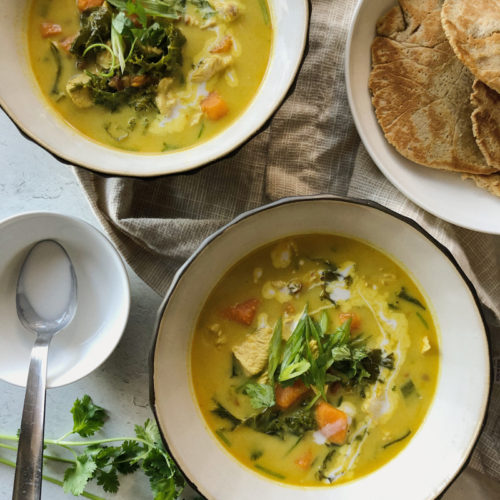Okay guys, I am SO excited about this naan recipe. Maybe it’s not fair to call it naan since it doesn’t have those classic pockets of air throughout fluffy dough. That’s why I’ve also added “flatbread” to the recipe title for you sticklers. The point is that this flatbread is perfect to eat with curries, stews, sauces, dips – you name it! And the best part is that it fits all of the different diet categories I have here on my site – Low FODMAP, Paleo, Whole30, Vegan AND AIP-friendly. And to me, that’s absolutely amazing!
I will admit, the dough is a little hard to work with (hence the longer-than-normal amount of steps in the recipe). But I PROMISE you, it’s a lot easier than it seems, especially once you get the hang of it. And it’s TOTALLY worth it! So enough of my excited rambling. Let’s get into the ingredients, shall we?
Just so you know! This post may contain affiliate links, meaning I may earn a small commission when you click on links and make a purchase, at no additional cost to you. However, rest assured that I would never mention or recommend any specific products that I don’t use and love myself!
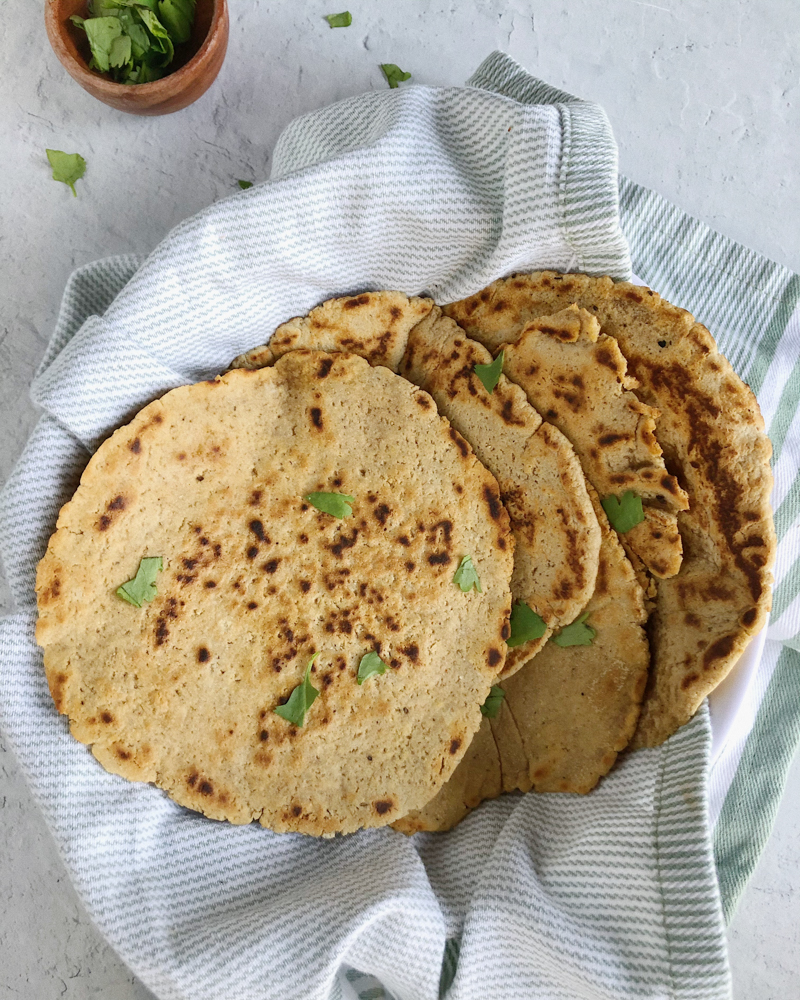
About the Ingredients & FODMAP Content
Cassava Flour or Tapioca Flour – So, up until 2 days ago, I had NO idea that Cassava Flour was only Low FODMAP in 15g servings according to FODMAPFriendly.com. (This is about 1/8 of a cup, or 2 tablespoons.) Thankfully, my tummy handled it well. In a hurry, I tested swapping it out for tapioca flour and the recipe still worked amazingly! Tapioca flour is safe in larger quantities, with a serving being 2/3 cup.
The only caveat is that the dough is impossible to roll out with a rolling pin, and the texture of the finished product is a tiny bit gummy once you start chewing (similar to pao de queijo aka Brazilian cheese bread). But still bready and delicious! If this sounds awful to you, you can improve on this and keep it low FODMAP by using up to 10 tablespoons of cassava flour and 6 tablespoons of tapioca flour (OR to keep it simple, 1/2 cup of cassava flour and 1/2 cup of tapioca flour). The more tapioca flour you use, the higher a chance that the outside will be slightly powdery, and the inside will be slightly more gummy than its all-cassava flour variation.

I get my cassava flour off of Amazon by Anthony’s Goods. And I love to use the tapioca flour from Thrive Market, or from Bob’s Red Mill.
Tigernut Flour – Tigernut flour is hard to substitute, as it adds the bready crumbiness to the final product. Without it, the dough will be more gummy. I also get my Tigernut Flour off of Amazon, by Anthony’s Goods.
Baking Soda, Cream of Tartar & Apple Cider Vinegar – These ingredients act together to give the flatbread a tiny bit of rise. The thicker your flatbread is rolled out, the more you will notice the rise (and the fluffier the inside will be).
Black Pepper – Gives the naan a little bit of a peppery kick. Omit for AIP.
Garlic-infused Oil – You can use non-flavored oil if you’d prefer, but I love the garlicky, savory flavor this adds! If you’re using a store-bought oil, be sure it is actually FODMAP-friendly. Depending on the manufacturing process, it’s possible that high FODMAP ingredients are in the final product. More on that in this article by FODMAP Everyday. My favorite garlic oil to use is by Garlic Gold, which I buy in bulk off of Amazon. If you don’t want to commit to a 6-pack, you can also purchase a single to try.
Unsweetened Plant-Based Milk – I use Macadamia Milk, but feel free to use any unsweetened plant-based milk that suits your diet and preferences. If on AIP, be sure your coconut milk does not contain any added gums, like this option by Native Forest.
Purified Water – Adding purified water allows for the crumbly mixture to turn into a dough. Be sure not to add too much as this will make the dough impossible to work with. I usually only add 2 tablespoons when using tapioca flour, and 3 tbsp when using cassava flour. This could vary depending on the brand of flour you’re using.
Avocado Oil – Any high-heat cooking oil will do. Only a little bit is needed for the frying pan.
Using Tapioca Flour
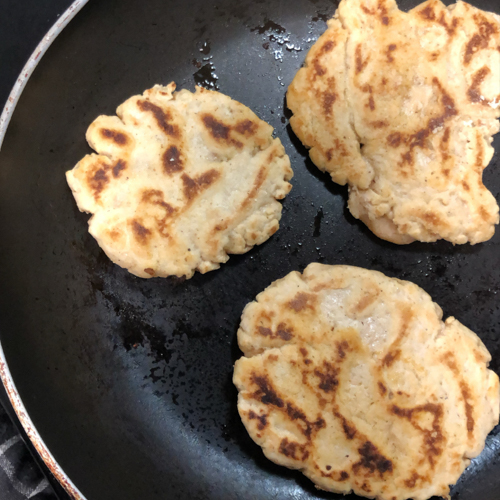
In a true Instagram vs reality fashion, here’s what my rushed attempt at subbing tapioca flour looked like. I only used my fingertips to flatten the dough since rolling it was near impossible. It’s the texture, flavor and what’s on the inside that counts, right? Because it’s still delicious.
Looking for something to pair with this delicious flatbread? Try my Thai Chicken Green Curry. Or keep it vegan by pairing it with my Roasted Red Pepper Hummus, or Chickpea Avocado Salad!
And if you make this Naan/Flatbread, be sure to leave a comment or give the recipe a rating or tag me on Instagram! I love it when you guys try my recipes. And I’d love to know if you enjoy them as much as I do! Enjoy! 🙂
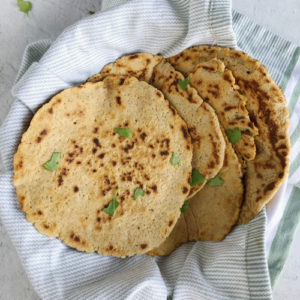
Naan Flatbread – Low FODMAP, Paleo, Whole30, AIP-Friendly
Equipment
- Large Bowl
- Frying Pan with Lid
- (Cassava Flour) Wax Paper
- (Cassava Flour) Rolling Pin
Ingredients
Dry Ingredients
- 1 cup total of cassava flour and/or tapioca flour use tapioca for lowest FODMAP
- ¼ cup tigernut flour
- ½ tsp baking soda
- ½ tsp fine sea salt
- ½ tsp cream of tartar
- pinch of black pepper omit for AIP
Wet Ingredients
- 2 tbsp garlic-infused olive oil
- ¼ cup unsweetened plant-based milk coconut milk without gums for AIP
- 1 tsp apple cider vinegar
- 2-3 tbsp purified water
- avocado oil for pan frying
Instructions
- Measure dry ingredients into a large bowl. Stir to combine thoroughly.
- Add garlic-infused olive oil, plant-based milk and apple cider vinegar. Mix thoroughly with a whisk or spatula to distribute wet ingredients. Mixture will be crumbly, like shortbread dough.
- Add water 1 tablespoon at a time, mixing thoroughly between each tablespoon. Add just enough water until the batter adheres to itself, making it possible to form a ball. Be sure not to add too much water, else the batter will be very difficult to work with.
If Using Cassava Flour (Paleo, AIP, Whole30)
- Separate dough into 5 equal parts and use hands to roll each piece into a ball.
- Chill dough in the freezer for 10 minutes to make it easier to work with.
- Once ready to roll out the dough, heat frying pan on medium to medium-high (about 6 out of 10) and add a small amount of avocado oil.
- If you're lazy like me and don't care for the wax paper & rolling pin process, and don't mind your flatbread being thicker and more bready, use palms and fingers to work the dough ball into a flattened shape, being careful not to rip the dough. Carefully transfer to the frying pan. Skip the next two steps.
- If you're up for the rolling pin process, place one dough ball in between two pieces of wax paper. Use rolling pin to flatten to desired thickness (the thinner it is, the crunchier it will be and the harder it will be to get it successfully from the wax paper to the pan).
- Carefully peel the top layer of wax paper off at a 90° angle to prevent the dough from tearing. Once the top layer is peeled, gently place the top layer back on, flip the wax paper sandwich over and repeat the process on the bottom layer. The dough should easily come off from the wax paper. Carefully transfer to hot pan.
- Cover the frying pan with a lid and cook on one side for 30 seconds to 1 minute, increasing time for thicker naan. When ready to flip, the edges will start to set and turn slightly darker (like pancakes), and the cooked side will have char spots. Be careful not to overcook it, otherwise it will harden and become more like a cracker. Adjust heat and time accordingly.
If Using Tapioca Flour (Paleo, Low FODMAP, AIP, Whole30)
- Once ready to roll out the dough, heat frying pan on medium to medium-high (about 6 out of 10) and add a small amount of avocado oil.
- Separate dough into 5 equal parts and use hands to roll each piece into a ball.
- Due to the consistency of tapioca flour, it will not be possible to roll it out with a rolling pin and successfully transfer it to the pan. Instead, use palms and fingers to work dough out into a thick flatbread. Carefully transfer to hot pan.
- Cover the frying pan with a lid and cook on one side for 30 seconds to 1 minute, increasing time for thicker naan. When ready to flip, the edges will start to set and turn slightly darker (like pancakes), and the cooked side will have char spots. Be careful not to overcook it, otherwise it will harden and become more like a cracker. Adjust heat and time accordingly.
Notes
- If using store-bought garlic-infused oil that is not certified FODMAP-friendly, make sure to use a brand that doesn’t list “garlic oil,” “garlic essential oil,” “garlic essence,” “garlic flavoring,” “natural roasted garlic flavor,” or anything similar in the ingredients list. There’s no way to know whether these ingredients are low FODMAP. More on that in this article on FODMAP Everyday.
Did you make this recipe?
Tag @thefodmapfactor on Instagram and hashtag it #thefodmapfactor. <3

